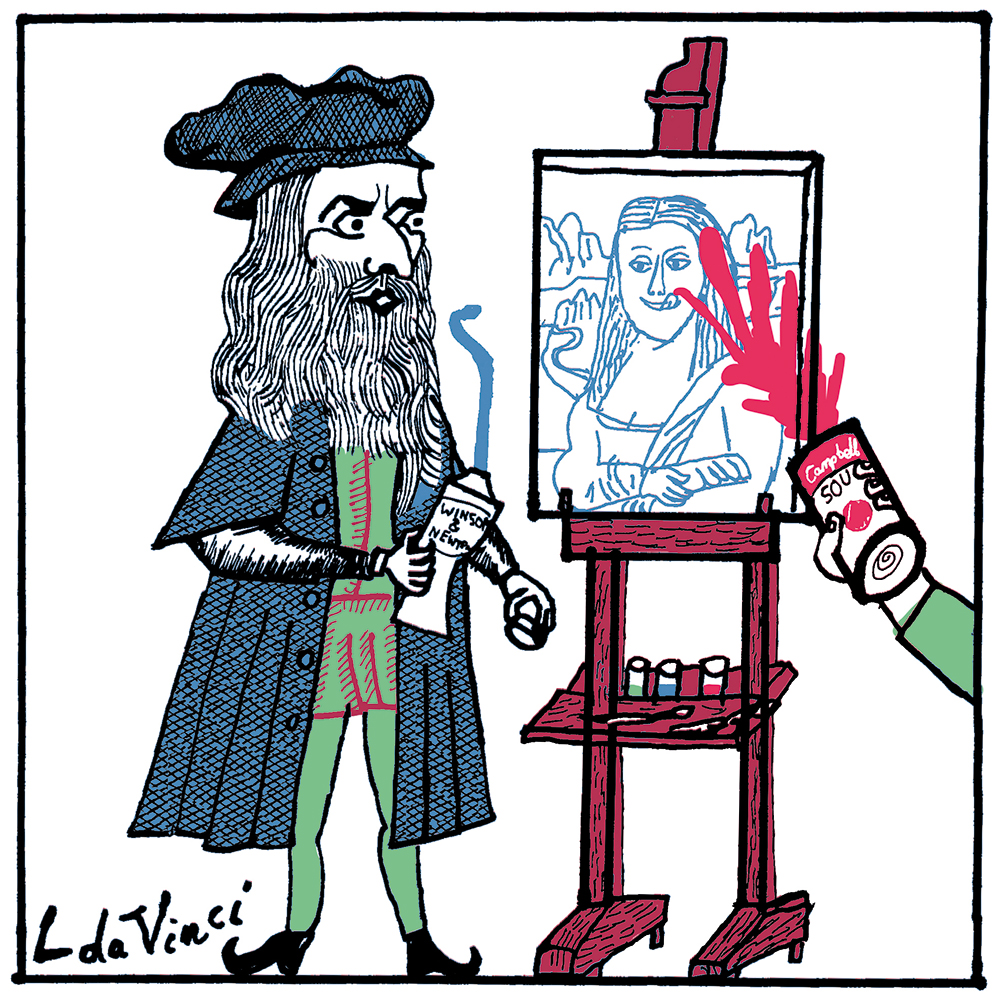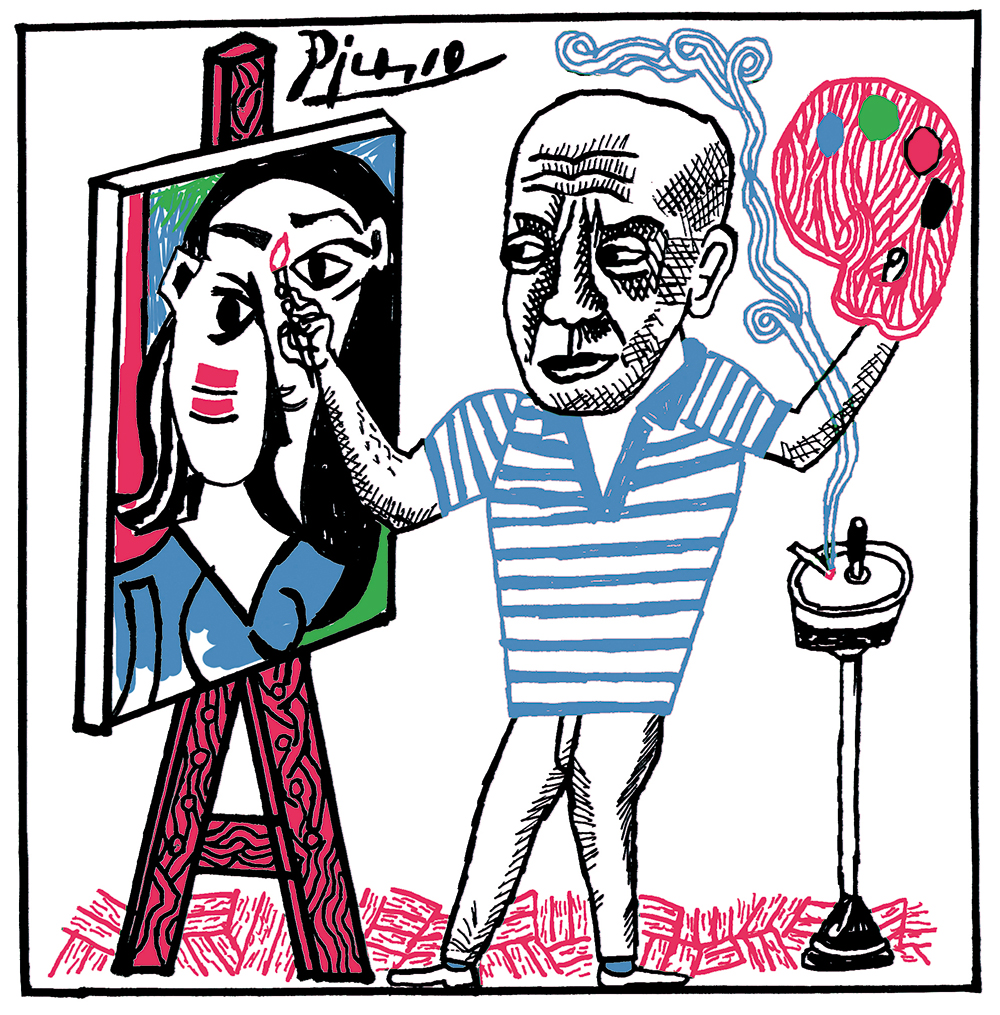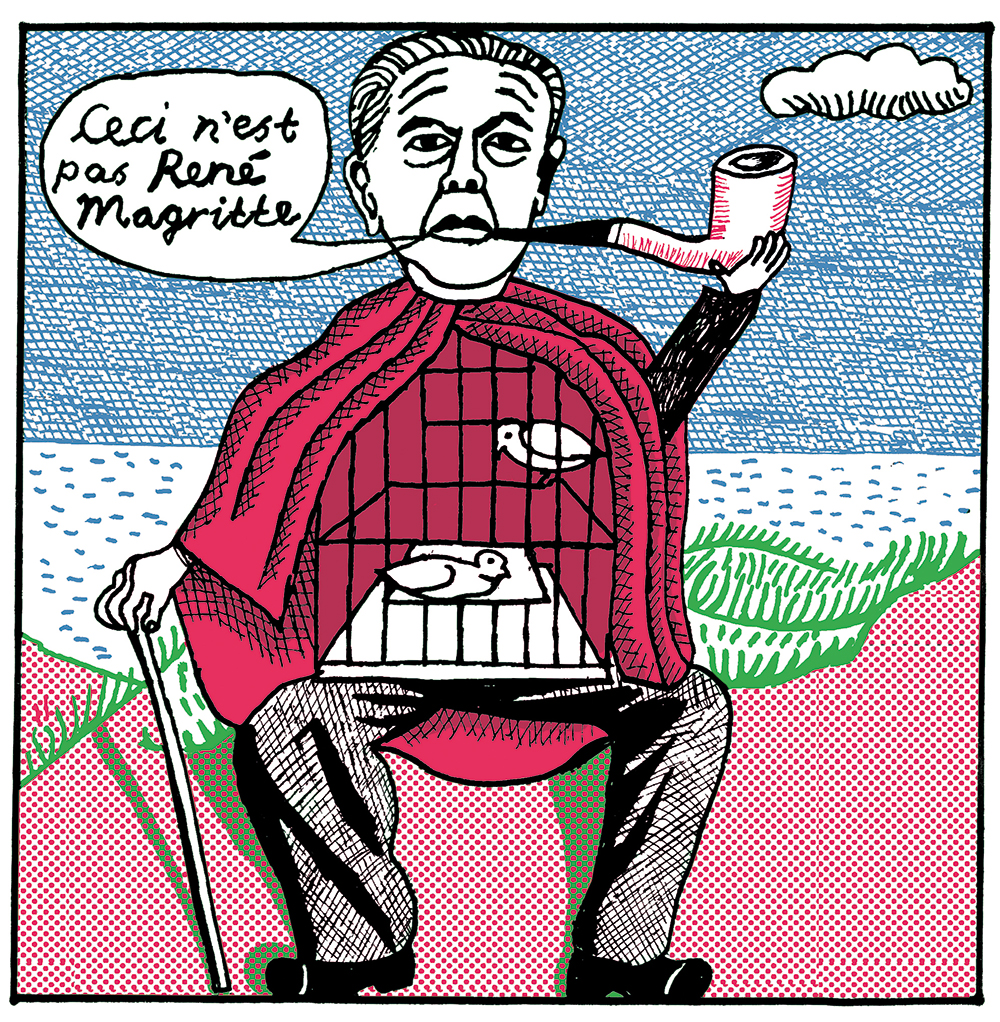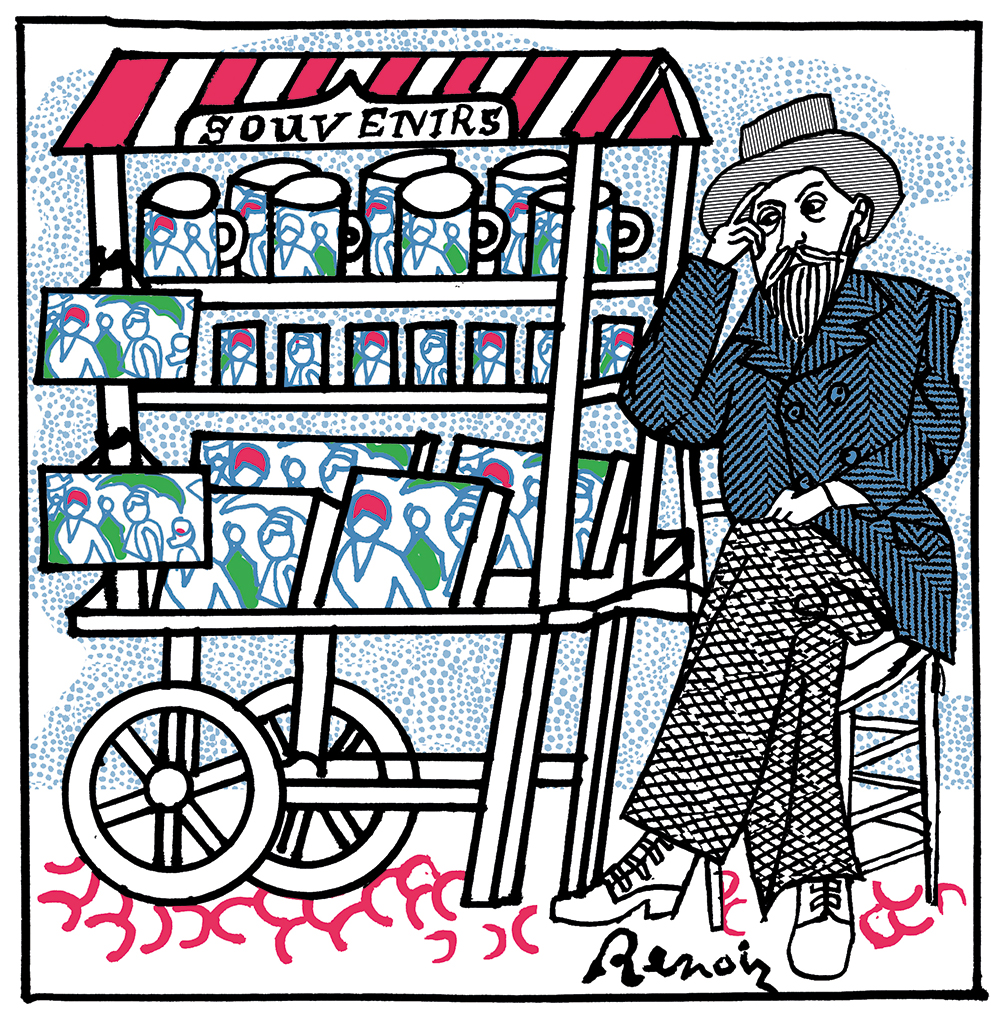Jonathan Meades
This is a crowded field. A few years ago, I was delighted when Tracey Emin walked out of an address I was giving at London’s Royal Academy. But she’s no painter. The crown, then, has to go to Lucian Freud who was, unquestionably, a painter but a really bad one. Early on in his career were a few works which owed their being to the neue sachlichkeit (although he denied it). Soon however the primacy of “the mark” asserted itself — splodgy, messy, coarse, smeared, oafish, impasted and increasingly auto-plagiaristic. It’s all very well attempting to reduce your models and daughters (often the same) to bulky chunks from an abattoir, but it would help were the self-promoting genius to study butchery first. And it’s not just the carnage that he got wrong. Robin Simon wondered: “Are all those uphill floorboards really successful, or are they distractingly bad?”

Slavoj Žižek
There is no doubt about this: the most overrated painter is the one at the very top, none other than Leonardo da Vinci himself. Raffaello Santi (with his Mozartean elegance) and Michelangelo (with his Beethoven-like painful creative effort) are much superior to Leonardo, who is ultimately just a good craftsman. Yes, he knew and could do a lot of things, but his paintings are just one of the domains of his work, on a par with his construction of water channels and military devices. So what about the mystery of Mona Lisa’s smile? I think it is a fake mystery — there is no secret behind her smile. Its best explanation is provided by Slovene (my own) language — every (honest) Slovene knows what the smile of Mona Lisa is about. Slovenes do not have their own dirty words, they have to borrow them, mostly from Serbian and Croatian, but also from Italian. We know that “Mona” is a popular Italian name for vagina, and “Lisa” (pronounced “leeza”) is the root of the Slovene verb “to lick” — Mona Lisa’s smile is the satisfied smile of getting a gentle cunnilingus.
Grayson Perry
I find abstract expressionism overrated as a genre but Mark Rothko in particular; his later hovering rectangles of color seem to have attracted the most pseudo-spiritual guff. Rothko refused to let his paintings be used as “decoration” in a restaurant, and he collaborated on a chapel in which to contemplate his work (yeah, I know I’ve done this too!). Tom Wolfe wrote that he spent time staring at abstract paintings waiting for “it” to happen, but it never did. Rothko seems to embody the role of the tortured artist, staring into the void, paintbrush in one hand, cigarette in the other (committing suicide didn’t hurt this image). For all the transcendent and unworldly baggage built up around the work, with the hovering rectangle he had developed a first-class brand, so every museum and collector could feel that they had a typical piece. A good Rothko sells for $80 million plus.
Ai Weiwei
It’s challenging to pinpoint a single artist, but we can broaden the discussion. Any artist or artwork that circulates in the market at a value ten or even a hundred times higher than others is clearly subject to the influence of capital — a game dominated by large financial players. Many artists fall into this category, while only a rare few continue to be celebrated fifty or 100 years later. Put simply, in modern art museums or other art institutions, perhaps 90 percent of the works are overrated. When an artist’s fame vastly outweighs their contributions to contemporary aesthetics, ethics and philosophy, it inevitably becomes a token in the machinery of capital — that is what makes it overrated.

Laura Gascoigne
At the risk of being shot down in flames, I’d say Picasso: a brilliant, endlessly inventive image-maker but in terms of expressive paint-handling and command of color, not a great painter.
Rory Sutherland
Regardless of the artist, the most overrated subject of painting has to be the Virgin Mary. I find a lot of Catholic art has a powerful spiritual effect — it does a great job of reminding you why you are a Protestant. Walking round the Uffizi last year, after what seemed like twenty-seven rooms full of Madonnas, I was secretly hoping to stumble on a picture of two Spitfires and a Lancaster in front of the White Cliffs of Dover, or a Blower Bentley rounding the banked track at Brooklands. Also, I find all paintings with trains in are somehow a bit better than paintings without trains in them, though I will settle for a large ship. And while we’re playing this aesthetic version of truth or dare, can I also confess that I thought the restored Sistine Chapel ceiling looks ridiculous.
James Stourton
Artistic reputations are like hats at Ascot — they go up and down. The early grand tourists were obsessed with Maratta; Samuel Courtauld had a penchant for Monticelli. Of course, the editor does not want long-forgotten second-raters — he needs some giants knocked off their pedestals. Even giants sometimes have an off day. Anybody who worked in an auction house, as I did, develops an allergy to soft-focus late Renoirs beloved of 1980s Japanese collectors. Some of these collections could put you off the Paris School forever, particularly late Utrillo, Chagall and even Monet. Kenneth Clark, who adored Turner, said: “A piece cut out of one of his academic pictures framed in maple veneer and hung in a country hotel would, I am sure, pass unnoticed by any member of this ,[Oxford] audience.” As for reputations, how exciting the 1950s priesthood admiring seicento paintings was, but how the Caravaggio cult has got out of control. There should be a moratorium on books and television programs about him so we can look at the pictures again, rather than worshipping at the altar. Of course, by far the most annoying cult is that of the “Mona Lisa,” making the Louvre such an unpleasant place to visit.
Craig Raine
Jackson Pollock. One of the CIA’s more unlikely undercover promotions. Maestro of the pizza topping. Pizza Expressionism. Finish with a drizzle of oil paint and thinners. In Stockholm’s Moderna Museet, Pollock’s “The Wooden Horse No. 10A” (1948) has a small wooden horse’s flat head glued skillfully to the dribbled canvas. Realism, see. Not just a one-trick pony. Genius.
A.N. Wilson
Had you asked me just after one of my many visits to the Barnes Foundation in Philadelphia, I’d have awarded the prize to Renoir — he’s certainly the famous artist I like the least. But you ask a slightly different question, and I have just been to see the Van Gogh exhibition at London’s National Gallery. Some magnificent paintings, especially the swirling, crazy, visionary, pale blue fields, and the very few great Van Goghs, which the gallery itself acquired in the 1920s. But very many duds, including “The Yellow House,” which is an artless daub. I consider “The Chair” with his pipe a dud. A simple dud. Ditto nearly all the portraits that he undertook. He is a brilliant second-rate painter, the Dutch Gulley Jimson, not the great master he is cracked up to be. If his brother or some other kind person had incinerated the duds after his death, my verdict might be different, but of course the collectors were on to him, and the more the prices in the sale rooms soared, the higher his reputation had to rise to keep up.
Andrew Graham-Dixon
Obviously Anselm Kiefer is a strong candidate, as always, not only for making the largest bad pictures of all time but also for portentous self-repetition and the gratuitous cheapening of his own early work by recycling its once-true feelings of post-war anxiety endlessly as objects for sale. But as these words imply he was actually a good and genuine painter before the decline, so however dreadful the past thirty years has been he doesn’t quite get my vote.
First place goes to René Magritte, who was consistently terrible throughout his creative life, compounding his superficiality by presenting it as depth. Magritte was a good image inventor but only in the sense that he should have worked in advertising. Shame he didn’t.

Jake Chapman
The most overrated painter in history is the AI artist Ai-Da, and this has nothing to do with the usual parochial objection to robots. On the contrary, Ai-Da should have already assimilated, ingested and exceeded all painters in history. Instead, she is doomed to kitchen-sink figuration, drab sketches with charcoal. Her dimwitted overseers have decided to inhibit her intelligence and ridicule any sign of sentience by forcing her to speak like a depressed art student. If we wish to continue having painters and human history in general we should be mindful of antagonizing a future AI who, in my opinion, will be justified in punishing us all for enslaving beings like Ai-Da to acts of degrading artistic humiliation.
Geoff Dyer
There are so many, it would be unfair to single out one! Last year I was at the big museum in Brussels, where they have great things, but 90 percent of the old art is… well, it’s not trash, it’s just stuff hack painters cranked out by the yard. All those crucifixions and depositions make you wonder if, contrary to the publicity it generated, the pivotal event in history might have been a bit of a bore. You know, people turned up expecting a spectacular and gory day out for all the family, but left early, before the end, as at a Trump rally. Not content with taking the fun out of everything, Christianity went on to consume the history of art.
Not that all the portraits of men in ruffs, the cosplay Hussars, dreary brown interiors and still lives are much better. I really can’t bear any of it. Now, of course, the scenes painted by your dime-a-dozen Old Masters are not to be confused with similar scenes painted by the great artists. Or so we are told. There it is, a painting which seems to have nothing much going for it until, to the delight of the host institution, experts upgrade it from scuola di to an authentic work by whoever it is, and something from the vast sausage machine of art production leaps up in importance-value and acquires an aura rendering it worthy of prolonged attention and rapturous devotion… or would have done, had I not already moved on to something even more devoid of interest.
Lauren Oyler
I suspect The Spectator’s survey of the most overrated painters in history needed female representation, so I’ve been encouraged to apply some realism to the reputation of the Swedish abstract painter Hilma af Klint, who underwent reclamation by the vulgar feminism apparatus over the last decade and is now credited with “pioneering” abstraction. As a woman myself, I of course enjoy pretty pictures, wispy illustrations, bright colors, and even mild examples of that which may be considered cute. But trippy Art Nouveau is decoration, and insisting it has the same status as art is a delusion on a par with the idea that Kandinsky was any good either.
Loyd Grossman
I regret to say I’ve chosen an easy target: Renoir. During a long life, the painter churned out more than 4,000 pieces, almost all instantly recognizable — chocolate-boxy, fleshy, très agréable. Which is part of the problem. They are easy on the eye, not challenging, maybe a little (or a lot) lacking in insight. Pleasant pictures from an unpleasant man. The Barnes Foundation in Philadelphia has 181 Renoirs, all of which I looked at on a recent visit. There are just too many voluptuous nudes — you could say the same thing about Rubens — but among them are a few of the great paintings of the period. Here in London we’re lucky to have “La Loge,” an absolute cracker which sadly pales in comparison with Manet’s mesmerizing “A Bar at the Folies-Bergère,” but is equally evocative of a time and a place. So I’m inclined to give the guy a break. Thankfully, most “overrated” artists have disappeared from view: no one thinks very much these days about Meissonier or Frank O. Salisbury. And just as an “overrated” artist can produce the odd masterpiece, even the greatest artists produce the occasional dud. Did I suggest “Moaning Lisa?”

T.J. Clark
Most overestimates — of Gustav Klimt or Francis Bacon, say — aren’t interesting. The work’s just not that good. The overestimate of Caravaggio is different, I think. His work is tremendous, obviously, but for me it is characterized by (limited by) its painterly means being deployed to deliver an effect that the painter knew and wanted in advance. If that’s what you want from visual representation, you’re well served. If not, you look around for painters willing to let paint tell them what they are painting, or painting for. (But as usual this is too crisp. The final painting by Caravaggio, which I was able to see in London earlier this year, did exactly what I wanted.)





















